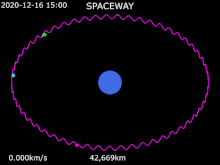Graveyard orbit


Earth · Spaceway-1 · Spaceway-2 · Spaceway-3
A graveyard orbit, also called a junk orbit or disposal orbit, is an orbit that lies away from common operational orbits. One significant graveyard orbit is a supersynchronous orbit well beyond geosynchronous orbit. Some satellites are moved into such orbits at the end of their operational life to reduce the probability of colliding with operational spacecraft and generating space debris.
Overview
A graveyard orbit is used when the change in velocity required to perform a de-orbit maneuver is too large. De-orbiting a geostationary satellite requires a delta-v of about 1,500 metres per second (4,900 ft/s), whereas re-orbiting it to a graveyard orbit only requires about 11 metres per second (36 ft/s).[1]
For satellites in geostationary orbit and geosynchronous orbits, the graveyard orbit is a few hundred kilometers beyond the operational orbit. The transfer to a graveyard orbit beyond geostationary orbit requires the same amount of fuel as a satellite needs for about three months of stationkeeping. It also requires a reliable attitude control during the transfer maneuver. While most satellite operators plan to perform such a maneuver at the end of their satellites' operational lives, through 2005 only about one-third succeeded.[2] Given the economic value of the positions at geosynchronous altitude, unless premature spacecraft failure precludes it, satellites are moved to a graveyard orbit prior to decommissioning.[3][4]
According to the Inter-Agency Space Debris Coordination Committee (IADC)[5] the minimum perigee altitude beyond the geostationary orbit is:
where is the solar radiation pressure coefficient and is the aspect area [m2] to mass [kg] ratio of the satellite. This formula includes about 200 km for the GEO-protected zone to also permit orbit maneuvers in GEO without interference with the graveyard orbit. Another 35 kilometres (22 mi) of tolerance must be allowed for the effects of gravitational perturbations (primarily solar and lunar). The remaining part of the equation considers the effects of the solar radiation pressure, which depends on the physical parameters of the satellite.
In order to obtain a license to provide telecommunications services in the United States, the Federal Communications Commission (FCC) requires all geostationary satellites launched after March 18, 2002, to commit to moving to a graveyard orbit at the end of their operational lives.[6] U.S. government regulations require a boost, , of about 300 km (186 mi).[7] In 2023 DISH received the first-ever fine by the FCC for failing to de-orbit its EchoStar VII satellite according to the terms of its license.[8]
A spacecraft moved to a graveyard orbit will typically be passivated.
Uncontrolled objects in a near geostationary [Earth] orbit (GEO) exhibit a 53-year cycle of orbital inclination[9] due to the interaction of the Earth's tilt with the lunar orbit. The orbital inclination varies ± 7.4°, at up to 0.8°pa.[9]: 3
Disposal orbit
While the standard geosynchronous satellite graveyard orbit results in an expected orbital lifetime of millions of years, the increasing number of satellites, the launch of microsatellites, and the FCC approval of large megaconstellations of thousands of satellites for launch by 2022 necessitates new approaches for deorbiting to assure earlier removal of the objects once they have reached end-of-life. Contrary to GEO graveyard orbits requiring three months' worth of fuel (delta-V of 11 m/s) to reach, large satellite networks in LEO require orbits that passively decay into the Earth's atmosphere. For example, both OneWeb and SpaceX have committed to the FCC regulatory authorities that decommissioned satellites will decay to a lower orbit – a disposal orbit – where the satellite orbital altitude would decay due to atmospheric drag and then naturally reenter the atmosphere and burn up within one year of end-of-life.[10]
See also
- List of orbits
- SNAP-10A – nuclear reactor satellite, remaining in a 700-nautical-mile (1,300 km; 810 mi) sub-synchronous Earth orbit for an expected 4,000 years
- Spacecraft cemetery, in the Pacific Ocean
Notes
- ^ Orbital periods and speeds are calculated using the relations 4π2R3 = T2GM and V2R = GM, where R is the radius of orbit in metres; T is the orbital period in seconds; V is the orbital speed in m/s; G is the gravitational constant, approximately 6.673×10−11 Nm2/kg2; M is the mass of Earth, approximately 5.98×1024 kg (1.318×1025 lb).
- ^ Approximately 8.6 times when the Moon is nearest (that is, 363,104 km/42,164 km), to 9.6 times when the Moon is farthest (that is, 405,696 km/42,164 km)
References
- ^ "Method for re-orbiting a dual-mode propulsion geostationary spacecraft – Patent # 5651515 – PatentGenius". Archived from the original on 2013-11-10. Retrieved 2012-10-28.
- ^ "ESA – Space debris mitigation: the case for a code of conduct". www.esa.int.
- ^ Jehn, R.; Agapov, V.; Hernández, C. (20 April 2005). "End-of-Life Disposal of Geostationary Satellites". Proceedings of the 4th European Conference on Space Debris (ESA SP-587). 587. ESA/ESOC: 373. Bibcode:2005ESASP.587..373J. Retrieved November 6, 2022.
- ^ Johnson, Nicholas (2011-12-05). Livingston, David (ed.). "Broadcast 1666 (Special Edition) – Topic: Space debris issues" (podcast). The Space Show. 1:03:05–1:06:20. Retrieved 2015-01-05.
- ^ "Report of the IADC Activities on Space Debris Mitigation Measures" (PDF). Archived from the original on 2015-04-02. Retrieved 2015-03-07.
- ^ "FCC Enters Orbital Debris Debate". Space.com. Archived from the original on March 8, 2005.
- ^ "US Government Orbital Debris Standard Practices" (PDF).
- ^ Shepardson, David (2 October 2023). "DISH gets first-ever space debris fine over EchoStar-7". Reuters. Retrieved 3 October 2023.
- ^ a b Anderson, Paul; et al. (2015). Operational Considerations of GEO Debris Synchronization Dynamics (PDF). 66th International Astronautical Congress. Jerusalem, Israel. IAC-15,A6,7,3,x27478.
- ^ Brodkin, Jon (4 October 2017). "SpaceX and OneWeb broadband satellites raise fears about space debris". Ars Technica. Retrieved 28 April 2019.





